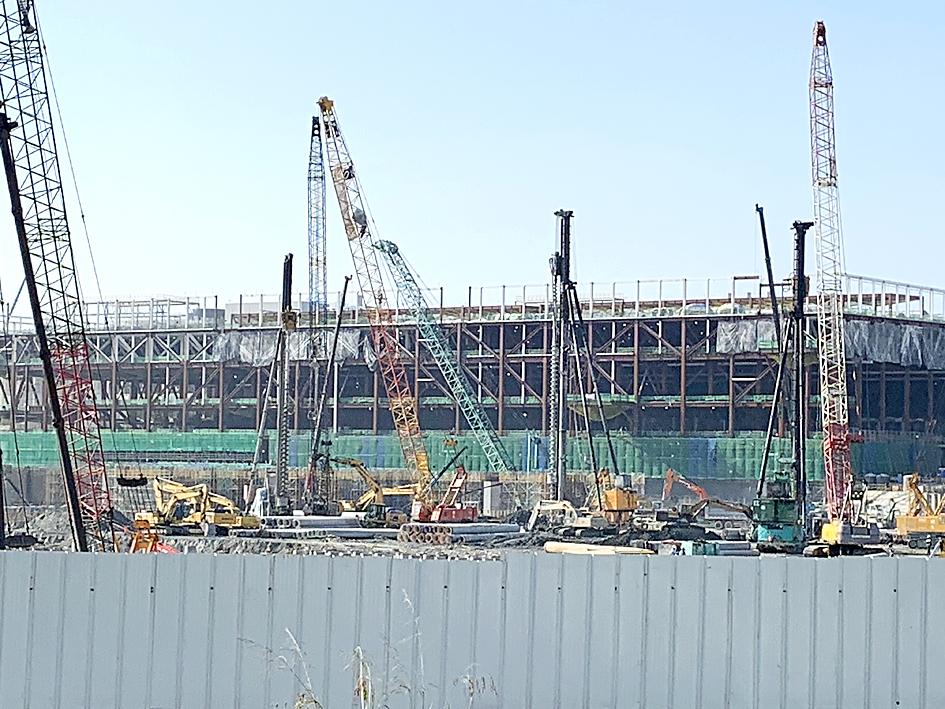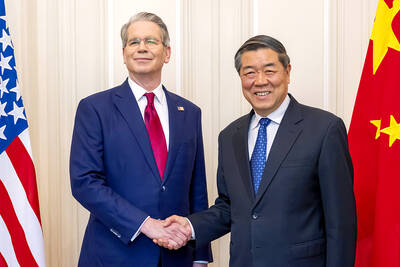Taiwan and China are to build more new high-volume semiconductor fabrication plants this year and next year than any other country, together contributing more than half of all new fabs in the world by constructing eight each, SEMI said in a quarterly report yesterday.
Global chipmakers are to start building 19 new high-volume fabs by the end of this year and another 10 next year to meet accelerating demand for chips from the communications, computing, healthcare, online services and automotive sectors, SEMI, an association that represents the global semiconductor sector, said in its quarterly report.
“Equipment spending for these 29 fabs is expected to surpass US$140 billion over the next few years, as the industry pushes to address the global chip shortage,” SEMI president and chief executive officer Ajit Manocha said.

Photo: Grace Hung, Taipei Times
“In the medium and longer term, the fab capacity expansion will help meet projected strong demand for semiconductors stemming from emerging applications such as autonomous vehicles, artificial intelligence, high-performance computing and 5G to 6G communications,” Manocha said.
China and Taiwan would lead the way with eight fabs each, followed by the Americas with six, Europe and the Middle East with three combined, and Japan and South Korea with two each, the report said.
In Taiwan, chipmakers such as Taiwan Semiconductor Manufacturing Co (TSMC, 台積電), Powerchip Semiconductor Manufacturing Co (力積電) and Vanguard International Semiconductor Corp (世界先進) are investing in new foundry fabs, SEMI said.
TSMC has raised its capital spending budget for this year to a record US$30 billion, and Vanguard, which makes driver ICs for displays and power management ICs, also boosted its capital expenditure for this year by 41 percent to NT$8.5 billion, while Powerchip in March started building a new 300mm fab with an initial investment of NT$278 million.
Chinese semiconductor firms are investing in fabs that make memory chips, foundry or auto chips, rather than advanced chips, SEMI said.
Fabs that produce 300mm wafers would account for most of the new facilities, with construction beginning on 15 fabs this year and seven others next year, SEMI said.
The remaining seven fabs planned over the two-year period would be 100mm, 150mm and 200mm facilities, it added.
The 29 fabs could produce as many as 2.6 million wafers per month in 200m equivalents, the report said.
Of the semiconductor makers beginning construction of new fabs this year, some would start installing equipment next year, but most would not do so until 2023, the report added.

RECYCLE: Taiwan would aid manufacturers in refining rare earths from discarded appliances, which would fit the nation’s circular economy goals, minister Kung said Taiwan would work with the US and Japan on a proposed cooperation initiative in response to Beijing’s newly announced rare earth export curbs, Minister of Economic Affairs Kung Ming-hsin (龔明鑫) said yesterday. China last week announced new restrictions requiring companies to obtain export licenses if their products contain more than 0.1 percent of Chinese-origin rare earths by value. US Secretary of the Treasury Scott Bessent on Wednesday responded by saying that Beijing was “unreliable” in its rare earths exports, adding that the US would “neither be commanded, nor controlled” by China, several media outlets reported. Japanese Minister of Finance Katsunobu Kato yesterday also

Jensen Huang (黃仁勳), founder and CEO of US-based artificial intelligence chip designer Nvidia Corp and Taiwan Semiconductor Manufacturing Co (TSMC, 台積電) on Friday celebrated the first Nvidia Blackwell wafer produced on US soil. Huang visited TSMC’s advanced wafer fab in the US state of Arizona and joined the Taiwanese chipmaker’s executives to witness the efforts to “build the infrastructure that powers the world’s AI factories, right here in America,” Nvidia said in a statement. At the event, Huang joined Y.L. Wang (王英郎), vice president of operations at TSMC, in signing their names on the Blackwell wafer to

‘DRAMATIC AND POSITIVE’: AI growth would be better than it previously forecast and would stay robust even if the Chinese market became inaccessible for customers, it said Taiwan Semiconductor Manufacturing Co (TSMC, 台積電) yesterday raised its full-year revenue growth outlook after posting record profit for last quarter, despite growing market concern about an artificial intelligence (AI) bubble. The company said it expects revenue to expand about 35 percent year-on-year, driven mainly by faster-than-expected demand for leading-edge chips for AI applications. The world’s biggest contract chipmaker in July projected that revenue this year would expand about 30 percent in US dollar terms. The company also slightly hiked its capital expenditure for this year to US$40 billion to US$42 billion, compared with US$38 billion to US$42 billion it set previously. “AI demand actually

RARE EARTHS: The call between the US Treasury Secretary and his Chinese counterpart came as Washington sought to rally G7 partners in response to China’s export controls China and the US on Saturday agreed to conduct another round of trade negotiations in the coming week, as the world’s two biggest economies seek to avoid another damaging tit-for-tat tariff battle. Beijing last week announced sweeping controls on the critical rare earths industry, prompting US President Donald Trump to threaten 100 percent tariffs on imports from China in retaliation. Trump had also threatened to cancel his expected meeting with Chinese President Xi Jinping (習近平) in South Korea later this month on the sidelines of the APEC summit. In the latest indication of efforts to resolve their dispute, Chinese state media reported that